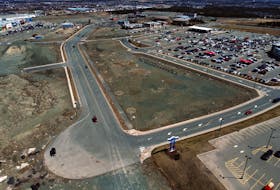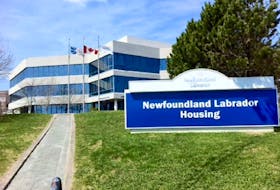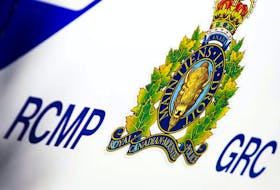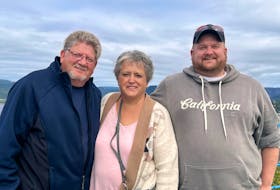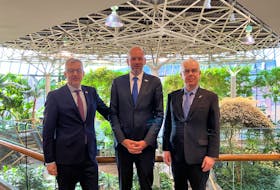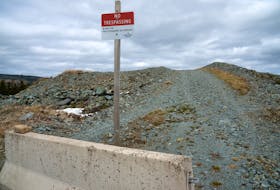
Many people using private wells washed their vegetables, brushed their teeth and swallowed glass after glass of water contaminated with arsenic.
Over the past year, testing of dozens of private wells — kick-started by serious illnesses, public concern and the initiative of a local doctor — revealed wells carrying water with arsenic levels from just past Health Canada’s recommended maximum to 100 times the max.
Some have tested clean, even right beside properties with a contaminated well.
In other cases, private wells have yet to be tested, with owners insisting on being ignorant to any health risks. There is no requirement for well owners to get testing for arsenic in their wells, beyond when the wells are first drilled.
However, according to health and environmental experts who have spoken with The Telegram, arsenic is something all well owners need to be concerned with on an ongoing basis — with calls for testing once every two to three years, to be sure a cancer-causing agent doesn’t creep into their daily routine.
Related story:
Need to be well aware — water well, that is
•••
In Valley Pond on New World Island, Geraldine White and her husband, Cec, like so many others, learned about the risks only recently, the hard way. On the advice of their doctor, after a test last year, they stopped drinking the water from their kitchen tap.
At 71 and 75 years of age, they now rely on their son — who is back and forth to Western Canada for work — and their homecare worker to help get jugs of water for drinking and cooking.
“I didn’t mind it so much myself, but doctors warned him,” Geraldine said of further use of the well, while sitting in her living room, giving a nod towards the door to the next room, where her husband was lying on the bed.
“I had breast cancer. I had three surgeries ... And now he had a big surgery last year,” she said of Cec, who was diagnosed with cancer and has since had his prostate and bladder removed.
“There’s no cure. It’s only just to try and keep him comfortable now, give him treatments,” she said.
“It’s been hard.”
It is impossible to say definitively if the well water was a contributor to their cancers, given the lack of baseline figures and other inputs possibly at play, including age, work history and other environmental factors.
What can be said is there was enough arsenic in their well — at 0.015 milligrams per litre — to place them at risk.
“There is overwhelming evidence that consumption of elevated levels of arsenic through drinking water is causally related to the development of cancer at several sites, particularly skin, bladder and lung,” the World Health Organization (WHO) stated, in a background document on arsenic in drinking water, created in support of WHO’s guidelines for drinking water quality, in 2011.
In Canada, the recommended maximum level of arsenic in water is no more than 0.010 milligrams per litre.
“We’ve got it,” said the Whites’ homecare worker, Kelly Wheeler, living a stone’s throw away.
She was referring to the presence of arsenic and she’s been picking up drinking water at the grocery store for months now, as well as making runs to a public water source about an hour away, in Gander Bay.
Wheeler said she believes arsenic in local wells has played a role in the emergence of serious illnesses.
She pointed to homes on the same street with dangerous water, noting she moved to the area a year ago last July and knows of between 10 and 15 people who have since died of cancer.
High arsenic levels have also shown up in the community of Bridgeport, including in Dale Dearing’s well.
“Ours was over 120-whatever. That’s really high. A lot of people had way up over 200 or more,” she said.
Taking it all in stride, Dearing has been borrowing water from someone with a cleared well. She is not sure about the long term.
“But most of all the houses around here got it,” she said.
In Moreton’s Harbour, Debbie Rideout’s well tested at 865 micrograms, or more than 86 times the recommended limit.
“We’ve been drinking that for 15 years,” she said, at work in her salon, in the downstairs of her home.
“My two boys were young when they started drinking it, so I worry about that.”
Her children, who now live away, have been asked to tell their family doctors about the arsenic levels. She said she and her husband are buying water and, with an expected visit from her granddaughter next week, it will also be bottled water for the guests.
The couple, like others affected, is still trying to determine a permanent fix, likely through the addition of a filtration system. But exactly what kind of system they will need, what it will cost, how it will be maintained and who will install it is still being determined.
•••
Back in Valley Pond, Elsie and Bruce Fudge — two of many in the area working turnarounds in Alberta — are home now and also buying water.
Their home was among the first tested in the checks for arsenic over the past year. It was done when their family doctor pressed for random testing in the community, in May 2014.
Their test returned a result of just over five times the allowable limit for arsenic — far less than their adult son’s well down the road, with more than 60 times the limit.
On their doctor’s advice, they immediately stopped normal use of the water supply — having relied on it for 24 years.
“Right away. He told us not to drink it no more,” Elsie said. “When you don’t know, you don’t care. But when you know there’s arsenic in it, and it may cause cancer ... we haven’t touched it.”
The couple has been looking for a filtration system for the arsenic, but has come across conflicting information as to what would be reliable, with proposed costs ranging from a few hundred dollars to a few thousand.
•••
The Whites, Wheeler, Dearings, Rideouts and Fudges are just a few of the families who spoke to The Telegram. Without Dr. Daniel Hewitt, who works out of the New World Island Clinic in Summerford, it is likely they would never have learned of the danger in their water.
Hewitt sought well tests in the area last year, following up on concerns being expressed by patients over the rate of certain illnesses.
“They weren’t aware about arsenic, but they were aware that there’s lots of sick people in their communities,” he said in an interview Friday.
He began wondering about potential environmental considerations and learned arsenic is plentiful in the ground in the area — so much so, it warranted establishing an arsenic mine near Moreton’s Harbour 100 years ago. He also learned about a Department of Environment map showing areas where high levels of arsenic were found in lake sediment, included a red and yellow band of higher risk tracking across central Newfoundland and was provided information from prospectors looking for gold in the region, finding higher-than-expected arsenic levels.
Hewitt contacted Health officials, a selection of local residents and a water testing company to get the ball rolling with initial testing and a public meeting.
“I think in our area, people (now) know. They know there’s an issue and some will choose to still drink the water, but most have decided probably they shouldn’t and a lot of people have had testing done,” he said.
“But I think there’s other parts of the island that are still not taking it seriously.”
•••
On New World Island, some areas are spared the concern and cost, being on shared and serviced water supplies, including the Town of Twillingate and Summerford. Elsewhere, according to Kerry Chaulk with DynaPro, a water testing company based in Lewisporte and sending off samples to a lab in New Brunswick for the arsenic checks, concerns in one area have been rolling into another as results come back.
“So we started doing Valley Pond, Moreton’s Harbour and then it breached over into Carter’s Cove, then it got down so far as Virgin Arm and then it went from Parkview to Too Good Arm and Pike’s Arm,” he said.
“We’ve found arsenic all around that area, everywhere.”
His company is in the process of providing filtartion systems for some residents.
•••
Isles of Notre Dame MHA and Natural Resources Minister Derrick Dalley, who was present at the public meeting, said there has been a lot of discussion about long-term solutions.
An offer was made — not for a full public water system, given the cost involved and the interest in maintaining private wells — but for a public water source in the worst-hit Bridgeport-Moreton’s Harbour- Valley Pond area, he said.
There has been no uptake on the offer from the local service districts, he said, with some residents citing cost. The community, with loose ties to start and uncertainty over responsibility, would have to collect a 10 per cent share for the project, estimated at $40,000.
Going the route of individual solutions, he said, supporting funding for filtration systems has been arranged for low-income households, through Newfoundland and Labrador Housing.
“It’s not been ignored. But we’ve taken it to a certain level and then you get to a point where, what can you do?” Dalley said, while encouraging anyone with ongoing difficulties to contact his office.
Living off a pension, with $162 a month set aside for homecare and trips to and from the doctors’ offices, the Whites are looking for some help, Geraldine said. They applied to the dedicated funding program but were turned down for assistance due to previous help with a furnace. So for now, they will rely on their water jugs.
Since 2008, Municipal Affairs has committed over $52.5 million for 84 drinking water projects in the province. The total investment in these projects, including municipal and federal funding, is over $117 million.
According to statistics available through the Canadian Cancer Society, the most commonly diagnosed cancers are lung, breast, colorectal and prostate cancer.
In 2014, an estimated 1,500 people will die of cancer in Newfoundland and 3,400 new cases will be diagnosed.

